By Erich Roden
The Detroit (MI) Fire Department quickly upgraded this single-company response because of the amount of smoke firefighters saw while responding. The first-arriving engine company found heavy fire in an apartment near the end of the public hallway on the fourth floor autoexposing the apartment above. Firefighters entered the main entrance to determine the exact location of the fire apartment from the interior as well as the layout of this large multiple dwelling. They stretched the first hoseline from the standpipe on the floor below and advanced up to the fire apartment. Because of the long L-shaped public hallways, the second or backup hoseline was stretched from another location rather than the standpipe. Although it is common to stretch the second hoseline from two floors below during a standpipe operation, firefighters should never overlook the obvious.
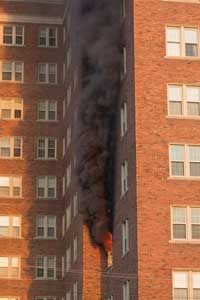 |
| (1) Detroit firefighters arrive to find fire on the fourth floor autoexposing the apartment above. This building has long public hallways and three stairwells: one near the main entrance and one at either end of the public hallways on both wings. The first hoseline was stretched off of the standpipe from the floor below the fire floor using the main entrance stairwell. (Photos by Steve Redick.) |
The second- or third-arriving engine company could easily stretch the second hoseline from the designated attack stair standpipe, two floors below, but it would still require at least one more length of hose than the first hoseline. Disciplined engine companies know that the less hose stretched the better. Less hose means less friction loss, kinks, and staffing needed to place a hoseline. The Detroit firefighters at this fire understood this as well and chose to find the most appropriate type of stretch and stairwell to use to quickly get the second hoseline placed and operating. Later-arriving engine companies opted for a rope stretch using the stairwell near the fire apartment and end of the public hallway.
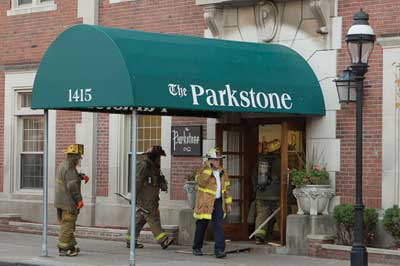 |
| (2) The first-arriving engine company entered the main entrance to determine the location of the fire apartment from the interior as well as the layout of this large multiple dwelling. You can determine the size and number of apartments per floor by counting the doors in the public hallway on each floor while ascending to the fire floor. This will allow you to determine how many working lengths of hose to estimate for the fire apartment based on size as well as lengths needed in the public hallway to reach the fire apartment from the stairwells. |
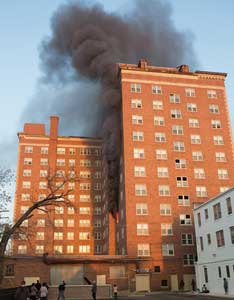 |
| (3) The second hoseline was stretched from another stairwell to facilitate a more rapid stretch to back up the first hoseline. The stairwell chosen was at the end of the public hallway nearest the fire apartment. These stairs are behind the off-center vertical line of windows in the center of the wing, with an exterior door at street level. This reduced the number of lengths needed in the stretch significantly and was performed using a rope stretch. The engine tasked with stretching the second hoseline ascended to the stairwell landing between the third and fourth floors, as the balance of the engine brought the hose to the base of the line of stairwell windows. |
Although a rope stretch is a rapid means to get successive hoselines into operation, consider several key points to ensure a successful stretch.
- It is advisable to bring at least three lengths of hose to be pulled up to the floor below to the base of the line of the stairwell or adjacent apartment windows being used. This will allow one length of hose to reach the stairs from an apartment or portion of the hallway being used, another length to reach the fire floor from the floor below that will be placed on the stairs, and the last to operate on the fire floor and apartment as the “working length.”
- Always use an apartment or stairwell window on the floor below-never on the fire floor, as this places the engine near the fire area without a charged hoseline.
- If the fire floor is above the fifth floor, an entire charged length of hose will be hanging out the window. This length of 13⁄4-inch hose can weigh up to 80 pounds and can pull the hose jacket and liner out of the coupling because of its weight with water. If this will be the case, tie the hoseline to a windowsill, sash, or radiator or anything under a window on a floor below with personal rope or a rope/hose/tool. This may prevent the loss of water if the liner goes and becomes bound up near the coupling.
- When opting for a rope stretch, limit each window on the floor below to only one hoseline if a third, or successive, hoseline is stretched. The point at which the hose comes into the window is a major friction and pinch point, and the firefighter at the window will have a hard time managing multiple hoselines with limited room near any window. Rather, since a stairwell window is the optimal choice for the first hoseline stretched with a rope, use the closest apartment window to the stairwell the first rope-stretched hoseline is using instead. (Remember, limit the number of hoselines on any stairwell to two, when possible, regardless of the type of stretch.)
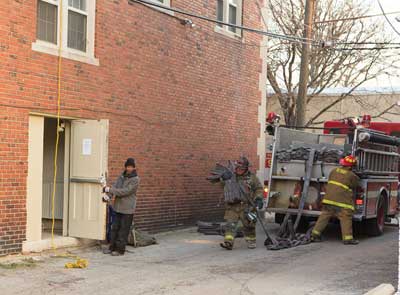 |
| (4) The engine company brought its “Detroit Bundle” to the drop point of the rope and secured the bundle to the rope for hoisting by the members on the stairwell landing above. Personnel then hoisted the rope, brought the hoseline into the landing, and flaked it out for an advance to the floor above. Bring in at least three lengths of hose to the floor below during rope stretches to reach the fire floor and provide enough hose to travel to and operate in the fire apartment. |
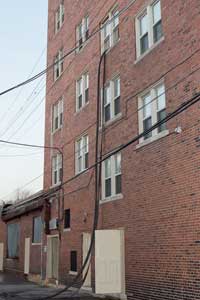 |
| (5) Here is a look at the vertical travel length of hose on the exterior of the building after the second hoseline was charged. Engine companies should remember that the weight of water in the hoseline is putting tremendous stress on the house couplings, liner, and jacket. Tying off the exterior length to a windowsill or sash will take much of the stress off the hose and reduce the chance of a loss of water, particularly if stretching a hoseline above the fifth floor. |
Because of the diligence and quick thinking by the later-arriving engine company at this fire, members quickly stretched the second hoseline and backed up the first hoseline when it was needed-during the first hoseline’s advance. Never overlook the obvious at any fire, even if standard operating guidelines state where to stretch the second and successive hoselines. The objective at these fires is to get multiple hoselines into operation, even if you have to adjust placement. As long as everyone on the fireground knows where hoselines are coming from, the first-arriving firefighters entering the fire apartment will surely welcome these adjustments.
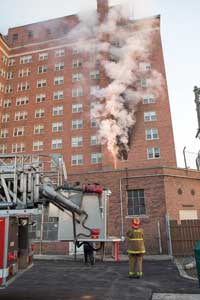 |
| (6) Conversion of the fire is seen quickly after arrival of the first-due companies, and the other areas on the fire floor and floor above near the main stairwell only experienced moderate smoke conditions. The second hoseline was stretched and placed in a timely manner because of quick-thinking engine officers, enabling the first-arriving engine and truck companies to operate in the fire apartment with confidence that the backup line was ready if needed. |
This fire was rapidly extinguished without multiple-alarm companies. The first-arriving chief officer was able to see conversion in the fire apartment in a timely manner and received reports of limited, accumulated smoke on the floor above. That’s a testament to getting the first and second hoselines into operation as quickly as possible, demonstrating that they are always the greatest life-saving tools on any fireground.
ERICH RODEN is the co-editor of Urban Firefighter Magazine and is a battalion chief assigned to the Training Division of the Milwaukee (WI) Fire Department. He is a member of the FDIC Executive Advisory Board, is a lead instructor for the FDIC “Urban Essentials” H.O.T. evolution, and was previously a H.O.T. instructor for “Engine Company Operations.” He is also a fire service instructor for the Milwaukee Area Technical College.


